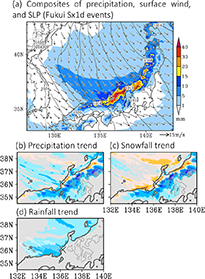** Progress in Earth and Planetary Science is the official journal of the Japan Geoscience Union, published in collaboration with its society members.
Gallery View of PEPS Articles
Research
Atmospheric and hydrospheric sciences
202302202302
Historical regional climate changes in Japan in winter as assessed by a 5-km regional climate model with a land surface process
Kawase H, Fukui S, Nosaka M, Watanabe SI, Otomo K, Murata A, Murazaki K, Nakaegawa T
Dynamical downscaling, regional climate model, JRA-55, global warming, extreme snowfall, snow cover change
Annual variations of annual maximum snow depth (SDmax) and linear trends simulated by the regional climate model, which is shown by the anomaly from 1991-2020. (a) The Japan Sea side of northern Japan (NJ-JS). (b) The Japan Sea side of eastern Japan (EJ-JS). Colors means elevation ranges and straight lines show the linear trends.
Composites of precipitation, surface wind, sea level pressure (SLP), and surface air temperature and linear trends of precipitation, snowfall, and rainfall when annual maximum daily snowfall (Sx1d) is calculated at Fukui city. (a) Composites of precipitation, surface wind, and SLP. (b-d) Linear trends of precipitation, snowfall, and rainfall [unit: mm/50 years). White and black dots show statistically significant grids with 90 and 95 % confidence levels, respectively.
We investigate historical regional climate changes in Japan from 1959 to 2020, analyzing a high-resolution dynamical downscaling forced by the Japanese 55-year Reanalysis (JRA-55). One-year continuous simulations are conducted by the non-hydrostatic regional climate model with a land surface model that includes the snow accumulation process, which enables us to evaluate the seasonal variation of snow cover in all of Japan. Our simulation reproduces interannual variations of the annual mean surface air temperature and annual total precipitation, and it shows rapid warming since around 1980. The annual maximum snow depth and annual maximum daily snowfall show significant decreasing trends at lower elevations on the Japan Sea sides of eastern and western Japan. Areas at higher elevations in eastern Japan show no trend in the maximum snow depth and a significant increasing trend in the maximum daily snowfall. In northern Japan, altitudinal dependencies in snow depth and snowfall changes are smaller on the Japan Sea side than on the Pacific Ocean side: the Japan Sea side shows insignificant changes in snow depth at all elevations, while the Pacific Ocean side shows decreasing and significant increasing trends at lower and higher elevations, respectively. The total number of snow-covered days is decreasing at most elevations in all regions, while the rate of decrease is smaller at higher elevations and latitudes. Composite analyses of annual maximum daily snowfall events at one prefectural city facing the Japan Sea in central Japan indicate that heavy daily snowfall occurs when the Japan Polar air mass Convergence Zone appears over the Japan Sea and the snowfall amounts show increasing and decreasing trends over the mountainous and coastal areas, respectively, due to historical warming and moistening. Our results are basically consistent with previous studies that have focused on future changes in snow depth and snowfall.







